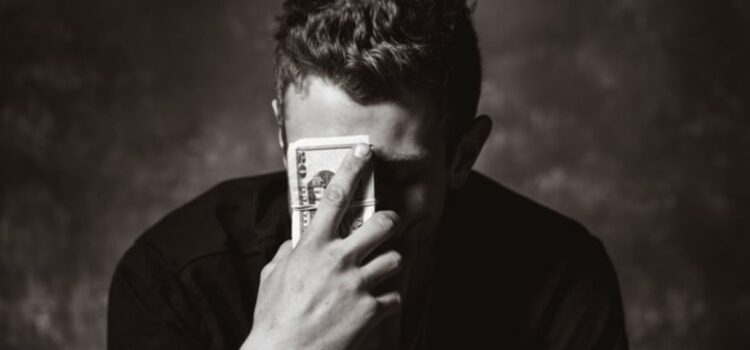

This article is an excerpt from the Shortform book guide to "Lost Connections" by Johann Hari. Shortform has the world's best summaries and analyses of books you should be reading.
Like this article? Sign up for a free trial here .
What is the relationship between socioeconomic status and depression? Why are highly unequal societies more likely to have higher rates of depression?
Socioeconomic status and depression are intertwined because an individual with a low or threatened social status is more likely to feel depressed. This problem is particularly acute in highly unequal societies. Those at the lower rung of the ladder are depressed because of their status, while high-status people feel depressed from the thought of falling down the ladder.
Read more about the relationship between socioeconomic status and depression.
Socioeconomic Status and Depression
Not all forms of in-person connections are helpful—if your social status is low or threatened, interaction with others can actually make depression worse. Surprisingly, the first researchers to study this relationship between socioeconomic status and depression weren’t psychologists or sociologists—they were primatologists studying the social hierarchies of baboons in Kenya. Monkeys and apes are humankind’s closest evolutionary cousins, and like us, they live in social communities. Studying those groups gives researchers a chance to see how the relationship between socioeconomic status and depression plays out in a much more concentrated way than they can when studying human communities.
Depression as a Submission Response
For baboons in particular, there is a strict hierarchy within the group. Female baboons inherit their place in the hierarchy from their mothers, but male baboons are constantly competing with each other for the top spots. Even the alpha male baboon’s position can be challenged by younger, stronger males. The competition is brutal—researchers can often identify low-status males instantly because they’re covered in so many bite marks from higher-status males asserting their dominance.
What does this have to do with human depression? The key is the way those low-status males cope with the constant abuse from high-status baboons. To avoid being ripped apart, low-status baboons make themselves as non-threatening as possible by lowering themselves physically. They bow their heads and keep their bodies low to the ground whenever other apes are around as a way of communicating, “You win. Please don’t hurt me. I’m not a threat.” Their posture, behavior, and energy levels mimic those of a severely depressed human.
The similarity between stressed baboons and depressed humans goes even further—both have elevated levels of the stress hormone cortisol in their blood, and both show the same changes in the brain, pituitary gland, and adrenal gland compared to their unstressed counterparts.
Because of these similarities, some scientists think that human depression is a submission response from deep in our evolutionary history. On a primal level, your brain can’t tell the difference between being savagely attacked by a competitive baboon and working a thankless job, being compared to unrealistic body ideals, or struggling financially—all of which make you feel “not good enough,” or like your status is low relative to people who are successful, thin, or rich. As a result, your brain reacts in the same way it would if you were being attacked. Whatever the cause, depression is the body’s way of saying, “You win. I give up. Just stop the pain.”
Low or Threatened Social Status Triggers Depression
This relationship between socioeconomic status and depression shows up in different situations depending on a baboon’s place in the social hierarchy: Low-status baboons are stressed almost constantly, and high-status baboons are acutely stressed when their status is threatened.
Generally, the relationship between socioeconomic status and depression works the same way in humans: When people are at the bottom of their social hierarchy, they’re more likely to be depressed. That makes intuitive sense—when life is harder, there’s more to be depressed about—but being at the top of the hierarchy can also trigger depression for humans if that status is threatened.
Sometimes, even having a social hierarchy at all can constitute a status threat because everyone feels the stress of needing to avoid falling to a lower rung of the social ladder. Research shows that highly unequal societies (with a large gap between those at the bottom and those at the top) have higher rates of depression for everyone, regardless of their spot in the hierarchy, than countries with more equal social structures. This is part of why countries like the United States (with the most unequal distribution of wealth of any advanced economy) have higher rates of all mental illnesses, including depression, than countries with more social equality (like Norway).
- If you imagine the social hierarchy as a physical ladder, Norway’s ladder would be one or two stories tall, while the United States’ ladder would be closer to five or six stories. A fall from either wouldn’t be pleasant, but a fall from the U.S. ladder would hurt a lot more—so there’s more pressure for high-status people to defend their position at the top, and that pressure can trigger a submission response like depression.

———End of Preview———
Like what you just read? Read the rest of the world's best book summary and analysis of Johann Hari's "Lost Connections" at Shortform .
Here's what you'll find in our full Lost Connections summary :
- The psychological and social factors that contribute to mental illness
- The history of antidepressants and the science behind them
- Why Amish people hardly ever get depressed






